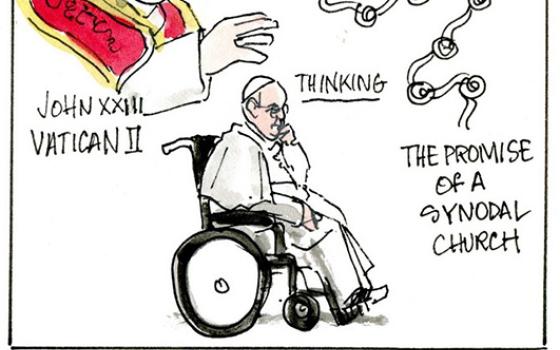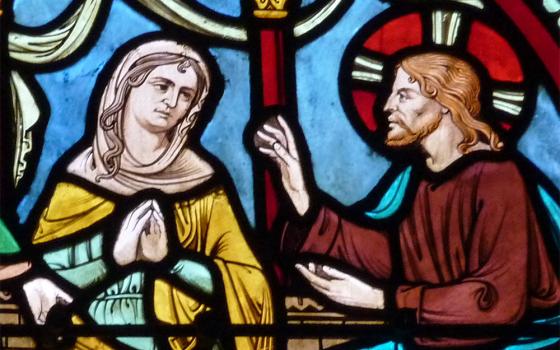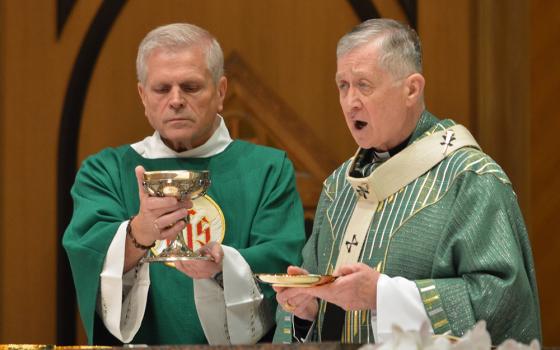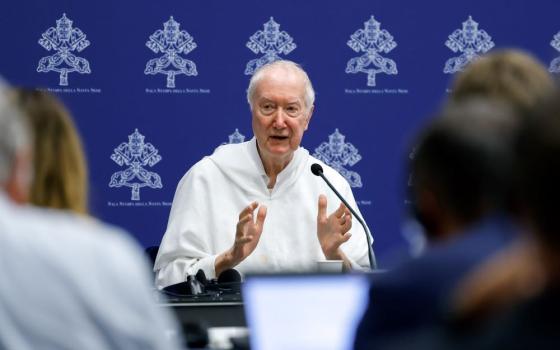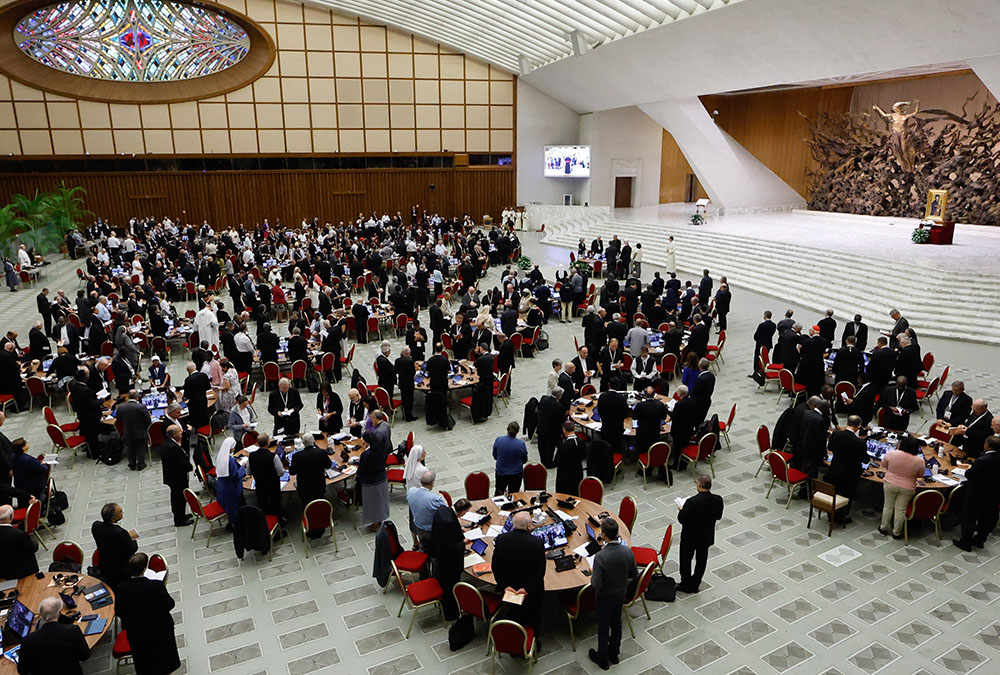
Members of the assembly of the Synod of Bishops pray with Pope Francis before a working session in the Vatican's Paul VI Audience Hall Oct. 16. (CNS/Lola Gomez)
In a recent and typically fine essay, Tom Reese elaborated on "15 hidden gems in the synod on synodality report." With this, Reese was inviting us to a second and more in-depth reading after the initial and mixed responses to "A Synodal Church in Mission," the synthesis report issued promptly after the close of the XVI Ordinary General Assembly of the Synod of Bishops in Rome Oct 4-29.
Note first that most see the move toward synodality as a renewed impetus for the vision of the Second Vatican Council (1962-65) as epitomized in Lumen Gentium, the Dogmatic Constitution on the Church. There, the council portrays the church as first a mystery and then "the people of God," before reflecting on its "hierarchical structure" — in a sense, turning the church upside down from its hierarchical pyramid.
Synodality now is the way forward that can engage the whole people of God as active agents of their faith, moving along together.
Yet there was serious disappointment with the synod's synthesis report on at least two crucial fronts: It did not endorse the ordination of women to the diaconate, and it made no explicit mention of full inclusion in the church for LGBTQ+ people.
Synodality now is the way forward that can engage the whole people of God as active agents of their faith, moving along together.
As a sign of hope, however, the report notes that while there was opposition, there was also a strong sentiment that admitting women to the diaconate would "restore the practice of the Early Church" and thus would be "faithful to the tradition." This prompts the reasonable cry of "What are we waiting for?"
Likewise, while it does not use the term LGBTQ+, the synthesis report repeatedly uses the word "welcome" as defining the imperative posture of the church toward all peoples.
Pope Francis' constant chant of "todos" is generally heard as highlighting a particular welcome for LGBTQ+ people. In his sermon on Sunday, Oct. 29, the day after this synod gathering closed, Francis called for — as he has so often — "a church with open doors that is a haven of mercy" for all.
There is also fresh hope for the church to develop a truly "catholic" (inclusive) stance toward its LGBTQ+ members in the repeated insistence in the synthesis report that, when addressing such social issues, theology needs to be in dialogue with the sciences.
For example: "It is important to deepen the dialogue between the human sciences, especially psychology and theology, for an understanding of human experience that does not merely situate these approaches side by side but integrates them into a more mature synthesis."
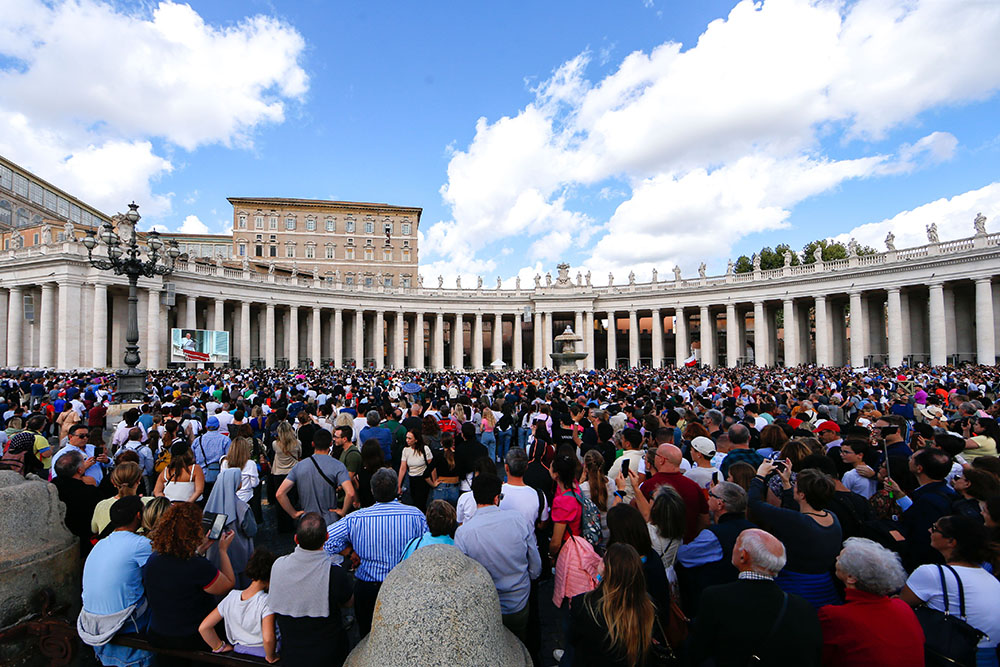
Visitors gather in St. Peter's Square at the Vatican to pray the Angelus with Pope Francis Oct. 29. (CNS/Lola Gomez)
Dialogue with the sciences, then, will help the church recognize the wide spectrum and the natural givenness of sexual orientation — rather than by choice — with all equally reflecting the image and likeness of God.
The Reese essay, however, invites us to look beyond such critiques of the synthesis report and to highlight the many positive aspects of the document that could be overlooked or skewed by its shortcomings. He found 15 "hidden gems" in all; I would like to elaborate on a few of them and add a few more.
Relocating priestly formation
The synod report often blames the current priesthood's "culture of clericalism" for many of its woes. For example: "Clericalism, a chauvinist mentality and inappropriate expression of authority continues to scar the face of the Church and damage its communion."
For this reason, "a thorough review of formation for ordained ministry in view of the missionary and synodal dimensions of the Church is called for," the report says.
The synthesis proposes that the church move the education of future priests out of the all-male environment of the traditional seminary and relocate to a more inclusive context that would engage "the whole ecclesial community," including women faculty.
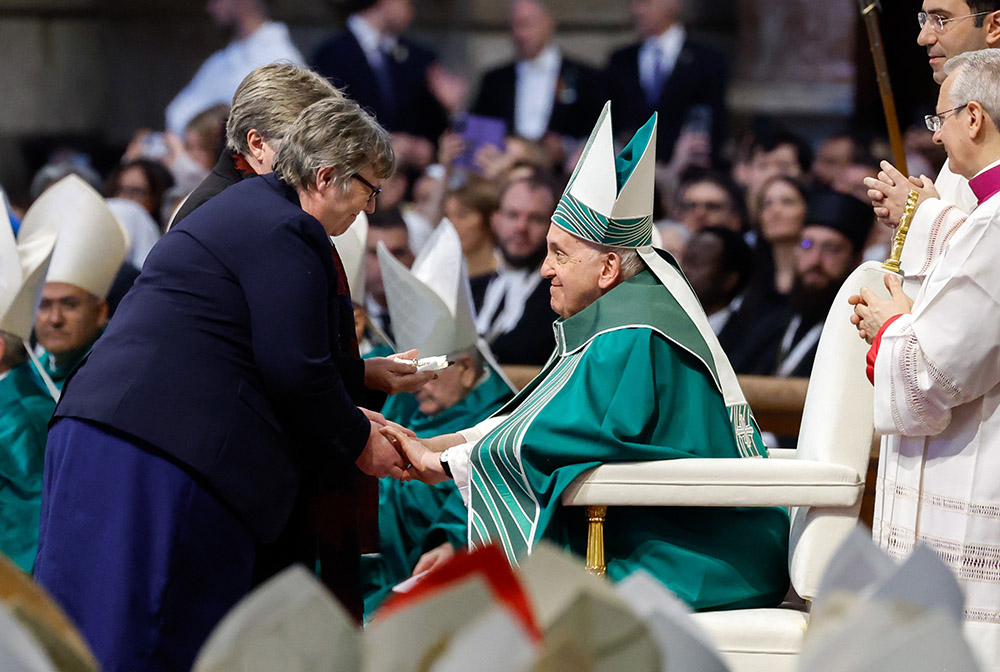
Pope Francis accepts the offertory gifts as he celebrates Mass marking the end of the first session of the assembly of the Synod of Bishops on synodality in St. Peter’s Basilica at the Vatican Oct. 29. (CNS/Lola Gomez)
More people to preach
This hopeful nugget is cast within what is a present ecclesial reality, namely that "pastoral practice at the parish, diocesan, and, recently, even universal levels, increasingly entrusts lay people with tasks and ministries within the Church itself."
Wanting to encourage such breaking open of formal functions of ministry to the nonordained, the report recommends "expanding responsibilities assigned to the existing ministry of lector" to "become a fuller ministry of the Word of God, which in appropriate contexts could also include preaching."
Taking preaching out of the exclusive hands of the ordained and opening it to laypeople with the requisite gift and theological background would surely expand the diversity of perspectives and spiritual resources represented in the preaching of our parishes.
Optional celibacy for priesthood
On this issue, the synod's lack of courage ranks with its avoidance on women in the diaconate, designating both as requiring "further study." Yet it reflects some hope that this is still an open question.
Advertisement
The report asks whether "for priestly ministry should [celibacy] necessarily translate into a disciplinary obligation in the Latin Church." The latter note recognizes implicitly that Eastern Orthodox Catholic Churches — as well as the Orthodox Church in general — maintain the option for their priests between the celibate life or being married. Indeed, the Roman church did likewise for its first 1,200 years or so, and more recently has admitted hundreds of married priests from Anglican and other high church traditions.
The possibility of married priests in the Catholic communion, and especially in cultures where priests are scarce, would bring a whole new breath of life to the church and its pastoral ministries. Let's hope the "further study" won't take long — like not beyond the next synodal assembly in fall 2024.
To reengage resigned priests in some functions of ministry
In the wake of Vatican II, literally thousands of priests in the Western church requested permission to resign from priesthood, the vast majority in order to marry. Many were granted a formal dispensation, but on the explicitly stated condition that they refrain from all functions and forms of ministry. For example, they (we) were forbidden to serve as lectors or eucharistic ministers.
Apart from the punitive attitude of such disbarment, it robbed the church of a huge pool of highly trained and talented ministers. How sad that they were not simply granted a dispensation from their promise of celibacy with permission to marry — and to carry on with their priestly ministry.
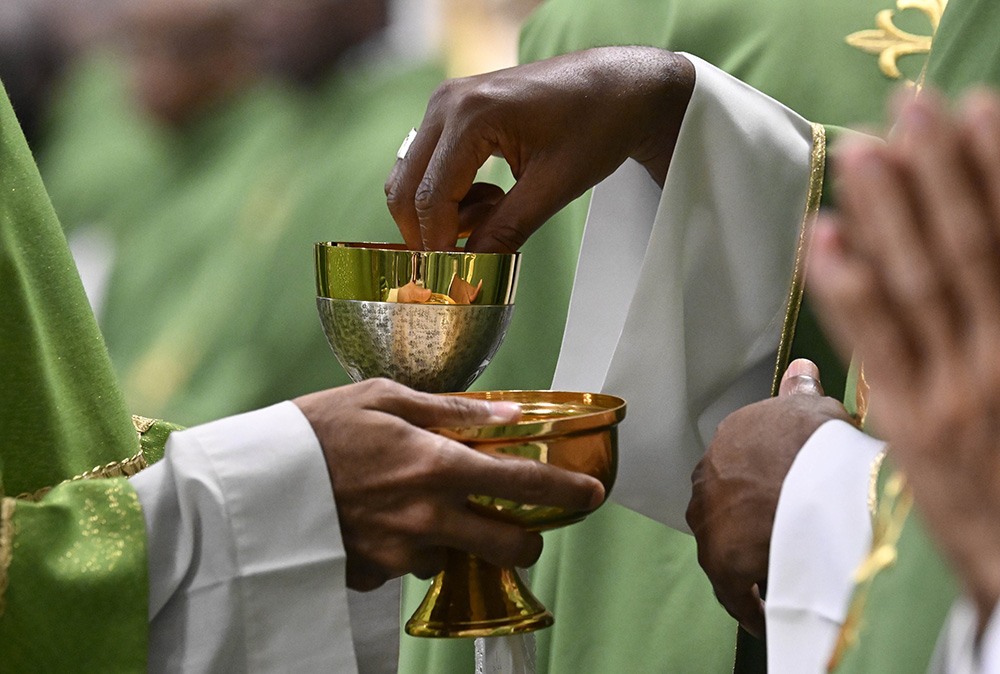
A concelebrating priest dips the host into consecrated wine during Mass in St. Peter's Basilica at the Vatican Oct. 29, marking the conclusion of the first session of the Synod of Bishops on synodality. (CNS/Vatican Media)
Though brief in its statement, it seems that the synod was at least open to some flexibility to reengage resigned priests in some active ministerial capacity. It states: "On a case-by-case basis, and in accordance with the context, the possibility should be considered of re-inserting priests who have left the ministry in pastoral services that recognize their formation and experience." And why not to preside at Eucharist?
Some possibility of shared Eucharist
In many cultures, marriage between Catholics and people from other Christian traditions is very common. Non-Catholic Christians are currently "prohibited by law" (Canon 912) from receiving the Eucharist. But might it be pastorally wise to welcome to the table Christian partners whose faith affirms the "real presence" of the risen Christ?
Without offering a decision, the synod appeared to be open to this possibility. It states: "We need to examine the issue of Eucharistic hospitality ... from theological, canonical and pastoral perspectives. ... This issue is of particular importance to inter-church couples."
An afterthought
The dominant scholarly opinion now is that admitting women to the diaconate would "restore the practice of the Early Church" and thus would be "faithful to the tradition." Theological logic suggests that they be admitted to priesthood and episcopacy as well. Note that we have always spoken of "holy orders" (plural) and yet have counted seven rather than nine sacraments.
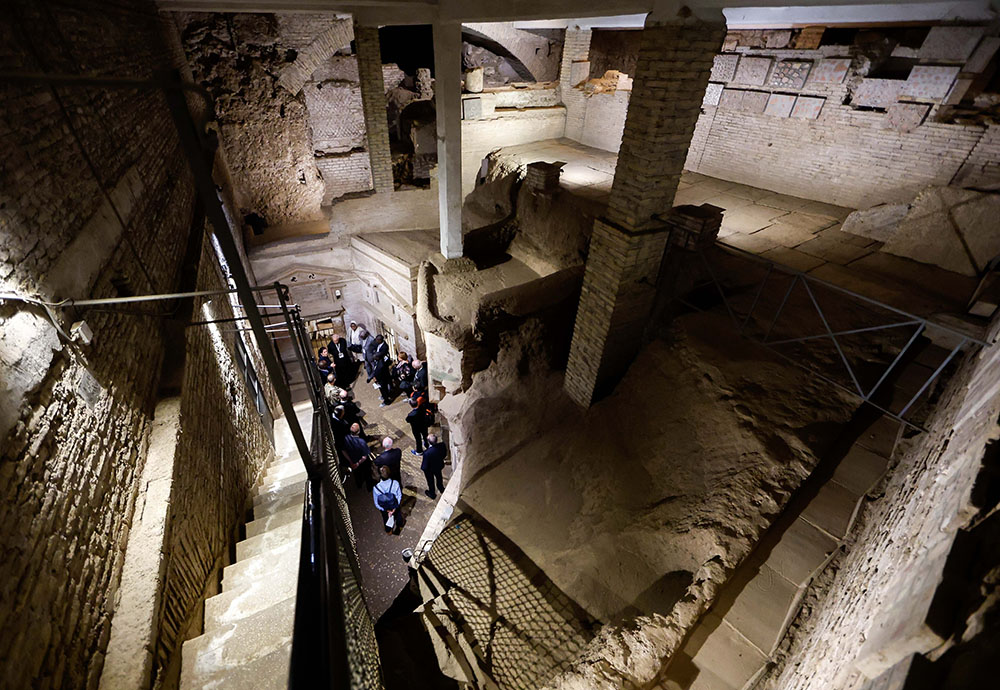
Participants in the assembly of the Synod of Bishops walk through the ancient Catacombs of St. Sebastian in Rome after praying at the Basilica of St. Sebastian as part of a pilgrimage Oct. 12. (CNS/Lola Gomez)
In other words, these three orders are all mediations of one and the same sacramental grace, albeit each ordered for three particular functions of service to the Christian community.
Sadly, the synod doesn't even mention this logical possibility regarding women in priesthood and episcopacy. Perhaps in the interest of first reaching wider pastoral consensus, this synod gathering thought it wise to "take one step at a time." Yet while waiting for women to be admitted to all three holy orders, it seems appropriate to cry out with the psalmist, "How long, oh God, how long?"
On a personal note, it may surprise that I was confirmed in my conviction that women be admitted to all three holy orders from my repeated praying of the Hail Mary (which I do 50 times a night — unless I fall asleep first). As I meditated on "Holy Mary, Mother of God," I began to recognize that Mary was the first to mediate the "body and blood" presence of God in human history with the conception and birth of Jesus.
Recognizing this theotokos role of Mary in the work of our salvation — as Mother of God — I became all the more convinced that no sacramental function can be validly denied to women. And as long as we deny their full inclusion in all orders of ministry we are well advised to ask Mary to "pray for us sinners."





